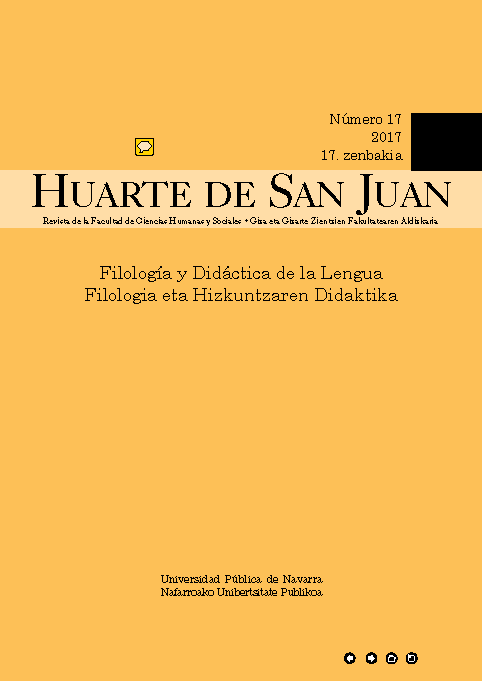Flipping the EFL classroom in a secondary education setting: Students’ perceptions and academic performance
Keywords:
Flipped classroom, EFL, secondary education, student-centred learningAbstract
The flipped classroom teaching model has gained a lot of popularity lately. The core idea of this new approach is to switch the class sequence moving direct instruction out of the classroom by making students watch videos that explain the content before coming to class. This way in-class time is freed up to implement student-centred activities that engage students and enhance active learning. Despite its popularity, studies regarding the implementation of the flipped classroom focus mainly on fields that are strongly based on lecturing, such as science, technology and mathematics, and on university settings. This case study aims to contribute to research on the implementation of the flipped classroom by extending it to an EFL classroom in a Secondary Education setting. Results obtained in pre and post-tests and in questionnaires showed that the flipped classroom improved students’ academic performance and this new teaching model was perceived positively by students.
Downloads
References
Alonso, F., Lopez, G., Manrique, D. & Vines, J. (2005): «An instructional model for web-based E-learning education with a blended learning process approach», British Journal of Educational Technology, 36 (2), pp. 217-235. Doi: 10.1111/j.1467-8535.2005.00454.x
Ahmed, M. A. E. A. S. (2016): «The Effect of a Flipping Classroom on Writing Skill in English as a Foreign Language and Students’ Attitude Towards Flipping», US-China Foreign Language, 14(2), pp 98-114. Doi: 10.17265/1539-8080/2016.02.003
Anderson, L. W. & Krathwohl, D. R. (eds.) (2001): A Taxonomy for Learning, Teaching, and Assessing: A Revision of Bloom’s Taxonomy of Educational Objectives, New York, Longman.
Baepler, P., Walker, J. D. & Driessen, M. (2014): «It’s not about seat time: Blending, flipping, and efficiency in active learning classrooms», Computers and Education, 78, pp. 227-236. Doi: 10.1016/j.compedu.2014.06.006
Barreras Gómez, M. A. (2016): «Experiencia de la clase inversa en didáctica de las lenguas extranjeras», Education Siglo XXI, 34 (1), pp. 173-196. Doi: 10.6018/j/253281G
Basal, A. (2015): «The implementation of a Flipped Classroom in Foreign Language Teaching», Turkish Online Journal of Distance Education, 16 (4), pp. 28-37. Doi: 10.17718/tojde.72185
Bergmann, J. & Sams, A. (2014): «Flipped Learning. Gateway to Student Engage-ment», Learning & Leading with Technology, 41 (7) 18-23. Retrieved from: http://www.learningandleading-digital.com/learning_leading/may_2014?pg=20#pg20
Bull, G., Fester, B. & Kjellstrom, W. (2012, August): «Inventing the Flipped Classroom», Learning & Leading with Technology, 40(1), pp. 10-11. Retrieved from: http://www.learningandleading-digital.com/learning_leading/201208?pg=12#pg12
Cockrum, T. (2014): Flipping Your English Class to Reach All Learners. Strategies and Lesson Plans, London, Routledge.
Coelho, D., Galante, A. & Pires, A. L. (2016): «Online Collaboration for English Learners: Implementing and International Project with Edmodo», Teaching English as a Second or Foreign Language. The Electronic Journal for English as a Second Language,19(4), pp. 1-15. Retrieved from: http://tesl-ej.org/pdf/ej76/int.pdf
Egbert, J., Herman, D. & Lee, H. (2015): «Flipped Instruction in English Language Teacher Education: A designed based Study in a Complex, Open-ended Learn-ing Environment», Teaching English as a Second or Foreign Language. The Electronic Journal for English as a Second Language, 19 (2), pp. 1-23. Retrieved from: http://tesl-ej.org/pdf/ej74/a5.pdf.
Evseeva, A. & Solozhenko, A. (2015): «Use of Flipped Classroom Technology in Language Learning», Procedia-Social and Behavioral Sciences, 206, pp. 205-209. Doi: 10.1016/j.sbspro.2015.10.006
Hao, Y. (2016): «Middle school students’ flipped learning readiness in foreign lan-guage classrooms: Exploring its relationship with personal characteristics and individual circumstances», Computers in Human Behavior, 59, pp. 295-303. Doi: 10.1016/j.chb.2016.01.031
Hsieh, J. S. C., Wu, W.V. & Marek, M. W. (2016): «Using the flipped classroom to enhance EFL learning», Computer Assisted Language Learning, pp. 1-25. Doi: 10.1080/09588221.2015.1111910
Hung, H. T. (2015): «Flipping the classroom for English language learners to fos-ter active learning», Computer Assisted Language Learning, 28(1), pp. 81-96. Doi: 10.1080/09588221.2014.967701
Kvashnina, O. S. & Martynko, E. A. (2016): «Analyzing the Potential of Flipped Classroom in ESL Teaching», International Journal of Emerging Technologies in Learning,11 (3), pp. 71-73. Doi: 10.3991/ijet.v11i03.5309
Mazur, A. D., Brown, B. & Jacobsen, M. (2015): «Learning Designs using Flipped Classroom Instruction», Canadian Journal of Learning and Technology, 41 (2), pp. 1-26. Retrieved from: http://www.cjlt.ca/index.php/cjlt/article/view/909/421
Muldrow, K. (2013, November): «A New Approach to Language Instruction – Flipping the Classroom», The Language Educator, pp. 28-31. Retrieved from: https://www.actfl.org/sites/default/files/pdfs/TLE_pdf/TLE_Nov13_Article.pdf
Prefume, Y. E. (2015): Exploring a Flipped Classroom Approach in Japanese Lan-guage Classroom: A Mixed Methods Study (Doctoral dissertation, Baylor University, Texas, USA). Retrieved from: https://baylor-ir.tdl.org/baylor-ir/bitstream/handle/2104/9569/PREFUME-DISSERTATION-2015.pdf?sequence=1&isAl-lowed=y
Toto, R. & Nguyen H. (2009): «Flipping the work design in an industrial engineering course», Proceedings, 39th ASEE/IEEE Frontiers in Education Conference, San Antonio, Texas, USA, pp. 1-4. Doi: 10.1109/FIE.2009.5350529.
Tucker, B. (2012): «The Flipped Classroom. Online instruction at home frees class time for learning», Education Next. 12(1). Retrieved from: http://educationnext.org/files/ednext_20121_BTucker.pdf.
Wong, K. & Chu, D. W. K. (2014): «Is the Flipped Classroom Model Effective in the Perspectives of Students’ Perceptions and Benefits?», in Cheung, S. K. S., Fong, J., Zhang, J., Kwan, R., Kwok, L. F. (eds.), Hybrid Learning. Theory and Practice, Shanghai, Springer, pp. 93-104.
Downloads
Published
How to Cite
Issue
Section
License
All articles are published under a Creative Commons (BY-NC-ND 4.0) license. Each article will be assigned a DOI.
Authors retain copyright of their work and grant the journal the right to the first publication. Authors can sign additional agreements to non-exclusive distribution of the published version of the article (for example, in an institutional repository) as long as appropriate attribution to the original publication is provided. Articles can be uploaded to institutional repositories immediately after publication.
Electronic distribution of the articles (for example, academic social networks or personal webpages) is allowed and encouraged.
The journal reserves the right to publicise the work in social networks and other electronic means.







